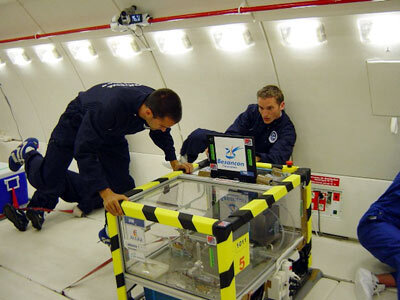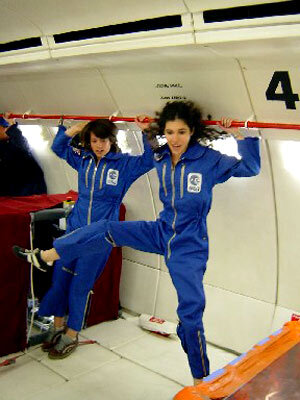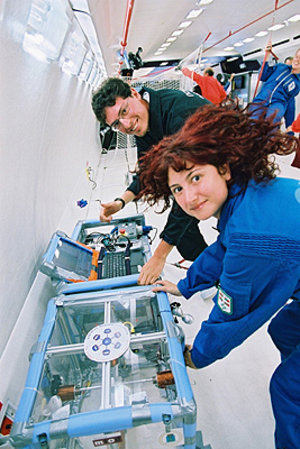Adhesive forces in zero-g
Team 1106 - Warsaw University of Technology We decided to wake up at 6:30 today. It didn’t take us much time to get out of the dorm since we’d packed everything already on Wednesday. At around 7 we arrived at Vera Cruz and had our breakfast. Then the coach took us to Novespace. Sobiesław and I put our flight suits on.
As is the tradition in Polish teams, we put the blue ESA towels on and attached white-red polish flags to our suits. Of course I didn’t forget Kacper, our teddy bear. We waited in the queue and filled out the forms. After a while we went out to board the plane.
Before the flight Sobiesław felt very confident, unlike I, who felt very anxious. The plane taxied directly to the runway without waiting too long on the taxiway. The take-off was full of energy, a preview of what was to come in a moment.
The weather was pretty good, the plane climbed to something like 8000 metres. After a while it descended and we heard “10 minutes to first parabola!” from the captain. Everybody got ready next to their experiments. All we had to do was push a button at the beginning of each parabola just before the injection phase and a second time after the “pull-out” message was broadcasted. Sobiesław decided to operate the digicam first, and I was to film him.
During the first parabola Sobiesław was doing exceptionally well, but I had some problems, I was flying everywhere, the orange guys had to put me back in place. But after that I got used to it too and everything started going really well. There wasn’t much work with the experiment, one person could easily take care of it, so we took turns going to the free floating zone to experience zero-g. We helped some people from other teams, most often at taking pictures of themselves during the zero-g phase while the other supervised the experiment.
Once we both managed to go to the free floating area at the same time. Thank you to the Italians for taking pictures of us.
Time flew by really quickly, the memory card in our camera filled up. During one of the breaks we put a fresh memory card and continued collecting data from our experiment not forgetting to simply enjoy the microgravity between switching the camera on and off. Very soon it was already the 31st parabola. It is hard to write about the microgravity right after experiencing it.
The landing went smoothly and soon we were going down the stairs looking for our friends Paweł and Michał, however they were eating lunch at SOGERMA. They preferred to have a lunch than to greet us, but the lunches there are so tasty that I can’t really blame them.
After the lunch we unloaded our experiment, it was easy. Then we started packing it and exchanging e-mail addresses with the other teams.
Team 1011 - Université de Franche-Comté

After waiting almost a year and a half, we are now in front of the Airbus A300 Zero-G. Climbing the stairs up to the plane allows us to remember each step the team has taken until today. We are now onboard, expecting to perform our experiment as well as possible.
Even if some of our colleagues have been sick during the familiarization flight, we remain confident and are sure it will be great.
Ready to take off, runway 23, clear sky … rotation…1, 2, 3…28, 29, 30… Already finished? 30 parabolas were quite short since we enjoyed them so much, but they were long enough to get some interesting results and leave an unforgettable picture in our minds.
Now we have to go back to work with these results and try to do our best to foresee further applications.
You can be sure that the Orbital Team is ready for new microgravity opportunities. See you in zero-g!
Team 1121 - Universite de Liege

Once upon a time, 80 fish took off with 2 physicist nurses and 2 aquariums onboard a very special plane. One aquarium was lit with the light up and the other with the light down.
But in zero-g, fish seem to have the same behaviour. They were disturbed by the different acceleration and a lot of them were quieter than expected.
From the method point of view, the experiment was a success. On a biological level, it wasn’t as spectacular as we expected but still 'positive', as our ethologist Johan said.
Fish and nurses enjoyed the flight. And as Vladimir rightly says, it is addictive!





